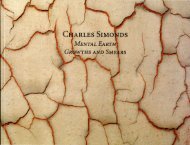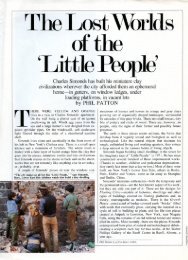Read Catalog - Charles Simonds
Read Catalog - Charles Simonds
Read Catalog - Charles Simonds
Create successful ePaper yourself
Turn your PDF publications into a flip-book with our unique Google optimized e-Paper software.
source. As has been noted in another context, although the Four Elements<br />
"are not a conception of much use to modern chemistry ... [they] are still<br />
the four elements of imaginative experience, and always will be." 21<br />
In Circles and Towers Growing, <strong>Simonds</strong> contrasts respectively the use of<br />
water and fire; but it is here a matter of predominance, not exclusivity. And<br />
again he requires us to exercise our imagination in order to see: we cannot<br />
literally peer down into the underground chamber beneath the central dome<br />
in Circles Numbers 4, 5, and 6 (pls. 35-37); but we can read in his account of<br />
the "People Who Live in a Circle" (below) the role of fire in the annual rites<br />
of rebirth. We can also find actual burnt things in many other Dwellings or<br />
ritual architecture pieces, implying the past presence of fire just as the prior<br />
mixture of water and earth is manifest in each brick. The landscape itself is a<br />
living chronicle of the "great cosmic marriage" between Sky Father and Earth<br />
Mother (as the Pueblo Indian cosmogony describes it), consummated through<br />
lifegiving rain. 22 Appropriately, <strong>Simonds</strong> mixes water with his various clays<br />
to replicate specific weathering effects: drying swamps, riverbeds, parched<br />
deserts. He also orders and domesticates water with constructed sluices (e.g.,<br />
Nu1nber 5, pl. 36) appearing in place of natural run-offs, signifying a higher<br />
state of evolution and the necessity of controlling water resources for the<br />
development of permanent communal societies. Water is a primary index by<br />
which we follow the course of the Circles and Towers cycle. Yet water itself<br />
is never literally present in the finished sculptures. This is one of the reasons<br />
that <strong>Simonds</strong>'s tabletop civilizations transcend the miniature effects of 1nodels<br />
and dioramas. As we know from Hollywood naval epics filmed on soundstage<br />
oceans, water-unlike earth-is nearly impossible to reduce convincingly in<br />
scale. Instead, as with so much else in these vivid little worlds that seem at<br />
first so overloaded with detail, we must again resort to imagination to infer<br />
water from the occasional pottery vessels, tree saplings, and (given the fact<br />
of permanent settlements) an agrarian culture.<br />
Neither does <strong>Simonds</strong> show us tiny figures frozen in games or meditation,<br />
casting shadows. As in so many photographic "portraits" of contemporary<br />
buildings, there are no people present to distract. He tells us the buildings are<br />
abandoned, but for five minutes or five centuries, he does not say. We have<br />
only the heights of doors, the distance between rungs on ladders, and similar<br />
subtleties as clues to the Little People's stature and thus the prevailing scale.<br />
Like fire and water and the underlying meanings of these deceptively simple<br />
works, the Little People themselves are quite invisible without the magnifying<br />
powers of imagination. And it is for the sake of imagination that they are<br />
not there.<br />
Everything depends upon our willingness to open up ourselves and mentally<br />
engage the vistas, bits and pieces, constructed by the artist. Imagination is<br />
simply the key to participation. 23 That is one reason why <strong>Simonds</strong>'s architectural<br />
references are indirect, never precisely reconstructions of Hopi pueblos<br />
and kivas, pre-Columbian terraces, Egyptian mastabas, Greek tholos tombs,<br />
or Iron Age brochs. Rather, his buildings and sites are evocative of all of these<br />
and more, together with their unavoidable associations of mythic prehistory<br />
and archaeologic interpretation. He calls these references "impressionistic," 24<br />
yet the allusions are to histories we understand were real, to the rise and fall<br />
of civilizations. <strong>Simonds</strong> appeals to our sense of historical fact-the meticu-












